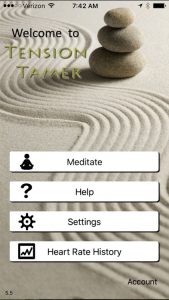Ethnicity Modulates Improvements in Sleep in Prehypertensive Patients with a Smartphone Meditation App
“Several practices that help calm the mind can also lower blood pressure. All are types of meditation.” – Harvard Health
By John M. de Castro, Ph.D.
High Blood Pressure (Hypertension) is an insidious disease because there are no overt symptoms. The individual feels fine. But it can be deadly as more than 360,000 American deaths, roughly 1,000 deaths each day, had high blood pressure as a primary or contributing cause. In addition, hypertension markedly increases the risk heart attack, stroke, heart failure, and kidney disease. It is also a very common disorder with about 70 million American adults (29%) having high blood pressure and only about half (52%) of people with high blood pressure have their condition under control. Treatment frequently includes antihypertensive drugs. But these medications often have adverse side effects. So, patients feel lousy when taking the drugs, but fine when they’re not. So, compliance is a major issue with many patients not taking the drugs regularly or stopping entirely.
Obviously, there is a need for alternative to drug treatments for hypertension. Mindfulness practices have been shown to aid in controlling hypertension. The vast majority of the mindfulness training techniques, however, require a trained teacher. This results in costs that many patients can’t afford. In addition, the participants must be available to attend multiple sessions at particular scheduled times that may or may not be compatible with their busy schedules and at locations that may not be convenient. As an alternative, Apps for smartphones have been developed. These have tremendous advantages in decreasing costs, making training schedules much more flexible, and eliminating the need to go repeatedly to specific locations.
In today’s Research News article “Ethnicity Differences in Sleep Changes Among Prehypertensive Adults Using a Smartphone Meditation App: Dose-Response Trial.” (See summary below or view the full text of the study at: https://www.ncbi.nlm.nih.gov/pmc/articles/PMC7576537/ ) Sieverdes and colleagues recruited patients diagnosed with prehypertension. They had the participants use a smartphone app, “Tension Tamer” for 6 months. The app provided focused breath following meditation practice and also measured heart rate and blood pressure. The participants were randomized into 3 dosage groups, 5, 10, or 15 minutes of daily practice. They were measured before and after training and at 1 and 3-months during training for sleep with a self-reports and 7-days of wrist actigraphy which also measured activity levels.
They found that the 47% of the participants who were African American had significantly shorter sleep durations, poorer sleep quality, and greater sleep disturbance at baseline both in the self-report and actigraphy measures than non-Hispanic white participants. They also found that the effects of the meditation app on sleep varied according to ethnic group. For the Non-Hispanic White participants, the 5-minute per day dose of “Tension timer” use produced significantly greater improvements in sleep efficiency and quality, lower fragmentation, and longer sleep duration than the 10 or 15-minute doses. For the African American participants, the 5-minute dose produced significantly less sleep fragmentation and duration than the 10 or 15-minute doses. In comparing the ethnic groups, they found that the Non-Hispanic White participants had significantly greater improvements in sleep efficiency, reduced fragmentation, and longer sleep duration than the African American participants.
These results are interesting and suggest that smartphone app guided meditation practice improves sleep in patients diagnosed as prehypertensive. But the effects are less positive for African American participants than Non-Hispanic White participants. This is a bit surprising as African American participants appear to have more problematic sleep to start with and hence had greater room for improvement. It is also surprising that the lower amount of meditation practice, 5-minutes per day, was more beneficial that the longer daily meditations. It appears that the 5-minute practice participants tended to use the app more often and to use it more often just prior to going to bed than the other dose participants and this may have led to the differences.
Improving sleep is important in promoting relaxation and reducing the likelihood that prehypertension will progress to patent hypertension. So, the use of the app may be helpful in maintaining the health of prehypertensive patients. The ethnic differences, however, suggest that app usage may be more beneficial for white as opposed to black participant. The results also suggest that brief daily practice, 5-minutes, may promote more frequent use that improves effectiveness.
So, ethnicity modulates improvements in sleep in prehypertensive patients with a smartphone meditation app.
“If you struggle with “turning your brain off”, you may find yourself feeling restless and unable to sleep. Fortunately, meditation is one way to quiet your thoughts and fight insomnia. Meditation has been shown to help people who struggle with insomnia and other sleep disturbances.“ – Florida Medical Clinic
CMCS – Center for Mindfulness and Contemplative Studies
This and other Contemplative Studies posts are also available on Google+ https://plus.google.com/106784388191201299496/posts and on Twitter @MindfulResearch
Study Summary
Sieverdes, J. C., Treiber, F. A., Kline, C. E., Mueller, M., Brunner-Jackson, B., Sox, L., Cain, M., Swem, M., Diaz, V., & Chandler, J. (2020). Ethnicity Differences in Sleep Changes Among Prehypertensive Adults Using a Smartphone Meditation App: Dose-Response Trial. JMIR formative research, 4(10), e20501. https://doi.org/10.2196/20501
Abstract
Background
African Americans (AAs) experience greater sleep quality problems than non-Hispanic Whites (NHWs). Meditation may aid in addressing this disparity, although the dosage levels needed to achieve such benefits have not been adequately studied. Smartphone apps present a novel modality for delivering, monitoring, and measuring adherence to meditation protocols.
Objective
This 6-month dose-response feasibility trial investigated the effects of a breathing awareness meditation (BAM) app, Tension Tamer, on the secondary outcomes of self-reported and actigraphy measures of sleep quality and the modulating effects of ethnicity of AAs and NHWs.
Methods
A total of 64 prehypertensive adults (systolic blood pressure <139 mm Hg; 31 AAs and 33 NHWs) were randomized into 3 different Tension Tamer dosage conditions (5,10, or 15 min twice daily). Sleep quality was assessed at baseline and at 1, 3, and 6 months using the Pittsburgh Sleep Quality Index (PSQI) and 1-week bouts of continuous wrist actigraphy monitoring. The study was conducted between August 2014 and October 2016 (IRB #Pro00020894).
Results
At baseline, PSQI and actigraphy data indicated that AAs had shorter sleep duration, greater sleep disturbance, poorer efficiency, and worse quality of sleep (range P=.03 to P<.001). Longitudinal generalized linear mixed modeling revealed a dose effect modulated by ethnicity (P=.01). Multimethod assessment showed a consistent pattern of NHWs exhibiting the most favorable responses to the 5-min dose; they reported greater improvements in sleep efficiency and quality as well as the PSQI global value than with the 10-min and 15-min doses (range P=.04 to P<.001). Actigraphy findings revealed a consistent, but not statistically significant, pattern in the 5-min group, showing lower fragmentation, longer sleep duration, and higher efficiency than the other 2 dosage conditions. Among AAs, actigraphy indicated lower sleep fragmentation with the 5-min dose compared with the 10-min and 15-min doses (P=.03 and P<.001, respectively). The 10-min dose showed longer sleep duration than the 5-min and 15-min doses (P=.02 and P<.001, respectively). The 5-min dose also exhibited significantly longer average sleep than the 15-min dose (P=.03).
Conclusions
These findings indicate the need for further study of the potential modulating influence of ethnicity on the impact of BAM on sleep indices and user-centered exploration to ascertain the potential merits of refining the Tension Tamer app with attention to cultural tailoring among AAs and NHWs with pre-existing sleep complaints.
https://www.ncbi.nlm.nih.gov/pmc/articles/PMC7576537/







